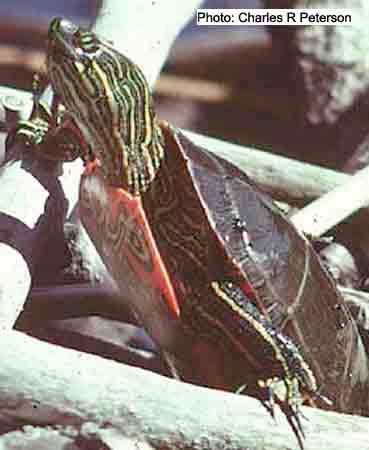
Chrysemys picta
(Painted Turtle)
Key Characteristics
Olive to black carapace
Red on bridge and plastron
Yellow and/or red lines on neck and limbs
Webbing between toes
General Description:
The Painted Turtle is the only species of turtle that occurs naturally in Idaho so identifying them should be straight forward. However, due to escaped pets and introduced species, one must become familiar with the general characteristics of Painted Turtles to avoid confusing them with such turtles as Box Turtles, and Red-eared Sliders (both common pet species). Painted Turtles are easily recognizable, their plastron, neck and limbs are so brightly colored with yellow or red lines and markings that the common name seems very apropos. Painted turtles have the generalized body form of aquatic turtles, having a somewhat shallow carapace (as opposed to the high domed carapace of a land tortoise) and having webbing between their toes which facilitates swimming. The carapace is usually a solid olive to black color but some light yellow vertebral lines can be present. The plastron contrasts with the dull carapace in being brightly colored with shades of red and yellow. Often, there is a dark central pattern that extends toward the margin of the plastron (Nussbaum et al. 1983).
Painted turtles can attain maximum carapace lengths of around 25 cm (~ 9 in.) (Nussbaum et al. 1983). Female Painted turtles are usually larger than males and the sexes can be further distinguished by the male's long front claws (Stebbins 1985), concave plastron and cloaca opening past the margin of the vent (Storm and Leonard 1995). Like all turtles, Painted Turtles lack teeth, and have a ridges or row of tubercules parallel with the margin of the jaw (Stebbins 1985).
During courtship, male Painted Turtles use their long claws to stroke the cheeks of the female to prepare her for mating (Nussbaum et al.,1983). Mating occurs at the bottom of the body of water and egg-laying most likely takes place during June and July (Nussbaum et al., 1983). Painted Turtles lay a clutch containing between 4 to 20 eggs in open areas that are exposed to the sun for much of the day, such as fields, roads, etc. (Storm and Leonard 1995). The eggs are white and elliptical in shape and hatch between 70 to 104 days later, and in some cases may overwinter until the following spring (Nussbaum et al.1983).
Idaho Distribution:
In Idaho, Painted turtles can be found in the northern portion of the state, and have recently been reported in western Idaho in waters associated with the Payette and Boise Rivers, and in eastern Idaho near St. Anthony.
From southern Canada to central Gulf Coast, and from East Coast to Pacific Northwest, with isolated populations in Colorado, New Mexico, and Mexico. Introduced and apparently established in other scattered localities in western states, including southeastern and southwestern Idaho.
Habitat:
Painted Turtles are found in shallow lakes and ponds, as well as in slow moving streams and rivers. Aquatic vegetation is usually present and the turtles will use this as cover to escape capture. The body of water will often have some floating debris, fallen logs etc. that provide basking sites for the turtles. Except for the trekk onto land for egg-laying, Painted Turtles are rarely found terrestrially.
Found in slow-moving, shallow water (streams, marshes, ponds, lakes, or creeks) containing soft bottom, suitable basking sites, and aquatic vegetation. May colonize seasonally-flooded areas near permanent water.
Diet:
Feeds opportunistically on various plants and animals, living or dead. In Idaho, aquatic insect larvae are major diet item of juveniles and adults.
Ecology:
Hibernates in water in bottom mud. Most active diurnally from March through October, though warm weather may stimulate activity in other months. Evening activity on land may occur during nesting. Eggs and hatchlings incur high mortality from various predators. Population density in ponds and lakes varies greatly; some areas may contain up to several hundred individuals/hectare, other areas may have as few as a dozen/hectare. Forages on water bottom or among aquatic plants.
Reproduction:
In Idaho, mating may occur in fall and spring. Most nesting occurs from late May to early July. Females often produce more than 1 clutch/yr; clutch size ranges from 8-19 eggs. Idaho study found hatchlings usually wintered in nest and emerged in spring. Females reach sexual maturity in 6-7 yr in northern Idaho.
Conservation:
|
Status: |
Protected nongame species |
|
Global Rank: |
G5 |
|
State Rank: |
S4 |
Important State Reference:
Lindeman, P.V. 1988. Comparative life history of the painted turtle, Chrysemys picta, in the inland Pacific Northwest. M.S. Thesis, Univ. Idaho, Moscow. 102pp.
Original images provided by Charles R. Peterson, ©1997
Species description, key characteristics and original html by John Cossel Jr.© 1997.
Updated design, image optimization and final revision by Ean Harker ©1999, 2000.
Adaptation for DAI by Stephen Burton 1999.

Elgaria coerulea
(Northern Alligator Lizard)
Key Characteristics
Lateral fold of skin
Elongate body
Brown (darkly pigmented) eyes
Dark edging on light colored ventral scales
General Description:
Northern Alligator Lizards are long-bodied lizards that are characterized by a distinct fold of skin (dorsolateral fold) that separates the keeled dorsal scales from the smooth ventral scales. The scales in the region of the fold are granular and contrast with the scale types on either side. These lizards are brown or brownish-green dorsally, and are light colored ventrally. The ventral scales are edged laterally with a dark line (this is different from the Southern Alligator Lizard, which has a dark line running down the center of the ventral scales). Northern Alligator Lizards have a somewhat triangular head with a pointed snout, and brown or darkly pigmented eyes.
Northern Alligator Lizards are medium sized, reaching sizes of around 100mm (4 in.) snout to vent length and 254mm (10 in.) total length (Nussbaum et al. 1983, Storm and Leonard 1995). The fairly long tail is usually less than twice the body length (Stebbins 1985).
Northern Alligator Lizards are one of only two species of Idaho lizards that give birth to live young (viviparous) rather than laying eggs (oviparous). The neonates emerge from transparent membranes soon after birth. The young lizards differ from adults by having a brassy or brownish-tan stripe dorsally that lacks much of the dark markings present on adults.
Habitat:
Northern Alligator Lizards are found in cooler and wetter environments than any other species of Idaho lizards. They are often found in forest clearings or edges, under logs and other surface debris. They can also be found in talus slopes that are associated with forests.
Idaho Distribution:
Northern Alligator Lizards are restricted to the northern portion of the state. Along Pacific Coast, from southern British Columbia through Washington and Oregon to central California. Also in Rocky Mountains from British Columbia, southeast to northern Idaho and western Montana.
Diet:
Feeds on insects, ticks, spiders, millipedes, and snails.
Ecology:
Hibernates in winter; duration of inactive period varies with local climate. Introduced cinnabar moths are poisonous to these lizards, and may have deleterious effects on northwestern populations. There are few records for this species in Idaho, possibly due to lack of surveys.
Reproduction:
Mating apparently occurs in April and May. In the Northwest, populations at higher elevations nest later in summer than lower-altitude populations. Females, which reach sexual maturity in 32-44 mo in northern California, produce 1 litter. Litter size averages 4-6 eggs, depending on locality.
Conservation:
|
Status: |
Unprotected nongame species |
|
Global Rank: |
G5 |
|
State Rank: |
S2 |
Species description, key characteristics and original work by John Cossel Jr. © 1997
Species ecological information from Groves et al. ©1997.
Original images provided by Charles R. Peterson© 1998
Design and Optimization by Ean Harker©1999, 2000.
DAI layout by Stephen Burton, and Mike Legler © 1999.

Crotaphytus bicinctores
(Mojave Black-collared Lizard)
Key Characteristics
Large size (head and body)
Black and white collar
Granular scales
Laterally compressed tail
General Description:
Mojave Black-collared Lizards are large headed, big bodied lizards with two distinct black collars separated by a white band. The dorsal coloration can range from a light tan to gray or reddish-brown, and is marked by fuzzy crossbands that are a lighter shade of tan or brown. There are usually light spots or speckles on the dorsal ground color. These light colored spots get more profuse on the limbs and tail, and begin merging to form a reticulated pattern. The ventral coloration is a light cream and is marked by charcoal or bluish-black colored patches on the groin and throat of males. In general, adult males tend to be more vividly colored, while females and juveniles have a lighter, more washed-out appearance.
Mojave Black-collared Lizards are one of the largest lizard species found in Idaho, with snout to vent lengths (svl) reaching 109 mm (4.3 in.) and total lengths reaching around 330 mm (13 in.) (Storm and Leonard 1995). The tail (which can add six or seven inches to the total length) is slightly compressed on the sides. This aids in distinguishing between Mojave Black-collared Lizards and Longnose Leopard Lizard, as the later have more rounded tails. Mojave Black-collared Lizards lack the ability to lose their tail along fracture planes, while Longnose Leopard Lizards can lose their tail (Pough et al. 1998).
Little is known about the details of Mojave Black-collared Lizard reproduction in the Northwest. However, based on information from more southern populations, it is likely that they mate in the spring, and lay a clutch of 3 to 8 eggs (Nussbaum et al. 1983). The neonates are similar in form and coloration to adults (see above regarding coloration).
Habitat:
Mojave Black-collared Lizards are associated with arid habitats, and a critical component of the habitat appears to be the presence of rocks and boulders. These lizards aren't adept at climbing, so the boulders are generally not too large. The surrounding vegetation is generally sparse (Storm and Leonard 1995).
Idaho Distribution:
Mojave Black-collared Lizards are found in southwestern portion of the state, along the Snake River Plain and surrounding Owyhee foothills. From northeastern California, southeastern Oregon, and adjacent parts of Idaho, Nevada, and western Utah, south into Arizona and southeastern California.
Diet:
Feeds mainly on insects and other lizards, but is also known to eat small amounts of flowers and leaves.
Ecology:
Hibernates/aestivates. Inactive during cold winter weather; duration of inactive period varies with local climate.
Reproduction:
Reproduction information for northwestern portions of range is lacking. In Arizona, eggs are laid in June or July, and hatch in October. In other areas in range, members of the same genus lay 1-2 clutches of 3-8 eggs/yr. In southern populations, some females mature after 1 yr.
Conservation:
|
Status: |
Unprotected nongame species |
|
Global Rank: |
G5 |
|
State Rank: |
S2 |
Important State Reference:
Diller, L.V. and D.R. Johnson.1982. Ecology of reptiles in the Snake River Birds of Prey Area. USDI Bur. Land Manage. Snake River Birds of Prey Research Project, Boise. 107pp.
Species description, key characteristics and original work by John Cossel Jr. © 1997
Species ecological information from Groves et al. ©1997.
Original images provided by William P. Leonard© 1998
Design and Optimization by Ean Harker©1999, 2000.
DAI layout by Stephen Burton, and Mike Legler © 1999.
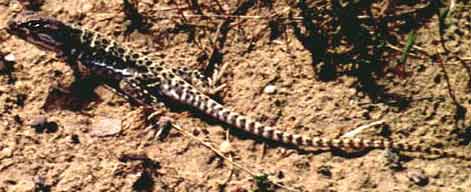
Gambelia wislizenii
(Longnose Leopard Lizard)
Key Characteristics
Large size (head and body)
Dark spots or blotches on light ground color
(forming two rows of spots on tail)
Dark streaks or lines on throat
Granular scales
Rounded tail
General Description:
Longnose Leopard Lizards have large muscular heads and bodies. They have granular scales with a light cream or tan ground color dorsally, and this is marked by a pattern of brown or black spots. The dark spots form two rows, which become more apparent on the long rounded tail. The tail can be more than twice the lizard's body length (Nussbaum et al. 1983). The coloration of Longnose Leopard Lizards can vary dramatically depending on the time of day (or their temperature). When cool, they appear very dark, and the dark spots are less prominent while light transverse lines become much more apparent (Storm and Leonard 1995). The ventral surface has a light coloration of white or cream that contrasts with the dark lines on the throat. The inside lining of the mouth and throat are black and when threatened, these lizards will readily reveal this by gaping their mouth and attempting to bite.
Longnose Leopard Lizards, along with Mojave Black-collared Lizards, are the largest lizards found in Idaho, as well the entire Northwest. Female Longnose Leopard Lizards are larger than males, with snout vent lengths of around 116 mm (4.6 in.) and total lengths of 331 mm (13 in.), (Storm and Leonard 1995). Like Mojave Black-collared Lizards, Longnose Leopard Lizards utilize their size and agility to include smaller lizards and other vertebrates in their diet. However, they do not eat other lizards exclusively. Based on the stomach contents of 21 lizards from southeastern Oregon, orthopterans (crickets and grasshoppers) may make up nearly half of their diet (Nussbaum et al. 1983).
Determining the sex of individual Longnose Leopard Lizards during the breeding season is relatively easy, due to the vivid salmon to orange color present on the neck and body and tail of females. These lizards mate in the spring, laying 4 to 7 eggs in June, which hatch in August or September (Storm and Leonard 1995). The neonates resemble the adults except that the light colored transverse lines are much more visible and they may have a reddish-rust color between the lines (Storm and Leonard 1995).
Habitat:
Longnose Leopard Lizards inhabit arid regions of the Northwest (Nussbaum et al. 1983). The soil is generally sandy, but may be other types (e.g. gravel or loess) as long as numerous rodent burrows are available (Behler and King 1979, Nussbaum et al. 1983). These lizards utilize burrows frequently and if the soil is suitable, they are capable of digging their own burrows. The surrounding vegetation is usually sparse and consists of desert shrubs and patchy clumps of grass (Storm and Leonard 1995). These lizards run after their prey (Stebbins 1985) and consequently thick vegetation is an impediment.
Idaho Distribution:
In Idaho the Longnose Leopard Lizard can be found in suitable habitat across much of southern portion of the state. From Idaho and Oregon, south to southern Baja California and north-central Mexico.
Diet:
Eats insects, spiders, lizards, small rodents, and some plant material.
Defense:
Ground-dwelling, but sometimes climbs into bushes. Home range varies; Nevada study identified range as less than 2½ ha, and population density as 5/ha. Hibernates/aestivates. Uses burrows of pocket mice and kangaroo rats. Inactive in underground burrows in cold weather. First active in early April in southeastern Arizona; in some areas, active in summer months only. One of the few lizards with a voice.
Reproduction:
In Idaho, lays clutch of 3-4 eggs in June or July. Eggs hatch in 5-7 wk; individuals become sexually mature in first or second year. Idaho study found years with spring rains led to greater insect prey availability and consequent higher rate of reproduction.
Conservation:
|
Status: |
Unprotected nongame species |
|
Global Rank: |
G5 |
|
State Rank: |
S5 |
Important State References:
Parker, W.S. and E.R. Pianka. 1976. Ecological observations on the leopard lizard (Crotaphytus wislizeni) in different parts of its range. Herpetologica 32:95-114.
Species description, key characteristics and original work by John Cossel Jr. © 1997
Species ecological information from Groves et al. ©1997.
Original images provided by Charles R. Peterson, and John Cossel Jr.© 1998
Design and Optimization by Ean Harker©1999, 2000.
DAI layout by Stephen Burton, and Mike Legler © 1999.
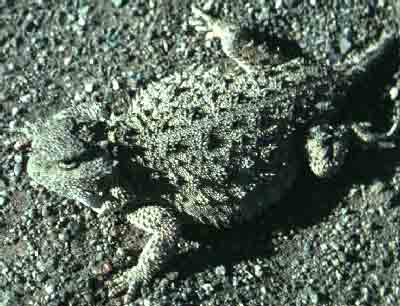
Phrynosoma douglassii
(Short-horned Lizard)
Key Characteristics
Flattened, rounded body
Horns on head and spines on body
Short horns (not longer than
they are wide at the base)
Viviparous (live-bearing)
General Description:
With their flattened and squat bodies, numerous spikes and horns on their heads, Short-horned Lizards are easily recognized as "horny toads" or horned lizards. In fact, their Latin name Phrynosoma is translated as "toad body". Short-horned Lizards range in color from pale gray with few markings, to a darker gray, tan, or reddish-brown ground color with two rows of darker blotches. The ground color will often be similar to the local substrate coloration. Ventrally, they are white or cream colored and they generally lack dark speckling. Short-horned Lizards have numerous small horn-like scales on their dorsum and a readily apparent single row of spine-like scales along their sides. The horns on the head of Short-horned Lizards are, as the common name implies, short, being no longer than they are wide at the base (Nussbaum et al. 1983). This feature helps distinguish Short-horned Lizards from the other species of horned lizard found in Idaho, the Desert Horned Lizard (Phrynosoma platyrhinos), which has much longer horns.
Short-horned Lizards are small to medium sized lizards depending on the subspecies, (i.e. the Pigmy Short-horned Lizard and the Salt Lake Short-horned Lizard respectively), (Nussbaum et al. 1983). They may attain sizes of around 66 mm snout-vent length (2.6 in.) and 100 mm total length (3.9 in.), (Storm and Leonard 1995).
The reproductive characteristics of Short-horned Lizards are another distinguishing feature that separates them from the congener, the Desert Horned Lizard. Short-horned Lizards are viviparous, giving birth to anywhere from 3 to 36 young (Stebbins 1985), but the maximum litter size in the Pacific Northwest is 15 (Storm and Leonard 1995). Desert Horned Lizards on the other hand are oviparous (egg-laying). Newborn Short-horned Lizards are very small, around 22 mm snout-vent length (Nussbaum et al. 1983) and resemble the adults.
Habitat:
Short-horned Lizards are found in a variety of habitats including open pine forests, pinion-juniper forests, shortgrass prairies and sagebrush desert (Nussbaum et al. 1983). The substrate can vary, but there is always some loose soil that allows these lizards to shuffle under the surface. Short-horned Lizards are more cold tolerant than any other Phrynosoma species; they can be found at elevations as high as 9000 feet and their range extends into Canada (Behler and King 1979).
Idaho Distribution:
In Idaho, the Short-horned Lizard can be found predominately in southern Idaho, with historic records in northwestern Idaho as well (Nussbaum et al. 1983). From southern British Columbia and southern Saskatchewan, south to northern California and northern Mexico.
Diet:
Varies from place to place, but includes ants and other insects, spiders, snails, sowbugs, and other invertebrates.
Ecology:
Hibernates/aestivates. When inactive, burrows into soil or occupies rodent burrow. In Idaho, adults are active from mid-April to August. Species is more cold tolerant than other horned lizards. Adults and juveniles are active during daylight hours, while young-of-year have bimodal activity patterns. Predators include longnose leopard lizard, Stellars Jay, Northern Shrike, and other birds.
Reproduction:
Mating has been observed in May in southeastern Idaho. Female gives birth to 3-36 young (3-15 in Pacific Northwest), from July to September, depending on range. Individuals become sexually mature in 2 or more years.
Conservation:
|
Status: |
Unprotected nongame species |
|
Global Rank: |
G5 |
|
State Rank: |
S5 |
Important State References:
Guyer, C. and A.D. Linder. 1985. Thermal ecology and activity patterns of the short-horned lizard (Phrynosoma douglassi) and the sagebrush lizard (Sceloporus graciosus) in southeastern Idaho. Great Basin Natur. 45:607-614.
Species description, key characteristics and original work by John Cossel Jr. © 1997
Species ecological information from Groves et al. ©1997.
Original images provided by Charles R. Peterson, William P. Leonard, and Henry J. Fabian.© 1998
Design and Optimization by Ean Harker©1999, 2000.
DAI layout by Stephen Burton, and Mike Legler © 1999.
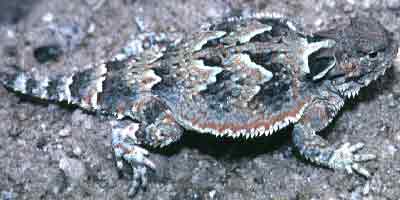
Phrynosoma platyrhinos
(Desert Horned Lizard)
Key Characteristics
Flattened, rounded body
Horns on head and spines on body
Long horns (longer than they are wide at the base)
Oviparous (egg laying)
General Description:
Desert Horned Lizards are variable in color, and their color scheme often matches the surrounding soil (Stebbins 1985). The coloration varies from gray, tan, or reddish-brown ground colors, with wavy dark blotches arranged in two rows (one on either side), (Storm and Leonard 1995). Two dark blotches on the neck are very prominent and are bordered posteriorly by a light white or gray color. The light border also penetrates in between the two neck blotches. Blotches that are similarly shaded (dark then a light border posteriorly) are also found on the tail, and they tend to form a banded appearance. The ventral coloration is generally white, and often speckled with dark spots.
Desert Horned Lizards have horns that are longer than they are wide at the base (which isn't true for their congener, the Short-horned Lizard), (Nussbaum et al. 1983). Another difference between the two species is that the head tapers much less on Desert Horned Lizards, giving them a very blunt-nosed appearance (their specific epithet "platyrhinos" translates as "flat nose"). In addition to the horns on their head, Desert Horned Lizards also have many small horn-like scales on their dorsal surface, and these scales form a single row that fringes the sides of these lizards.
Desert Horned Lizards are larger than Short-horned Lizards, and are capable of attaining sizes of about 95 mm snout-vent length (3.75 in.) and 140 mm (5.5 in.) total length (Storm and Leonard 1995). Although different in size, Desert Horned Lizards are similar to Short-horned Lizards in that both species prey primarily on ants. In fact, horned lizards can often be found in the vicinity of ant hills, where they sit and wait for ants to pass by (Nussbaum et al. 1983).
Although hard to determine in the field, another key difference between the two species of horned lizards found in Idaho is that Desert Horned Lizards are oviparous (egg laying). These lizards mate in the spring and lay 2-16 eggs in June, which hatch some time in August (Nussbaum et al. 1983). The young resemble the adults both in shape and in coloration.
Habitat:
Desert Horned Lizards are found in arid regions that have at least some loose soil available for burrowing. I generally find this species in areas with sandy soils and limited vegetation such as sagebrush or shadscale. However, they can also be found in areas with hardpan and gravelly soils as well (Behler and King 1979), (Nussbaum et al. 1983), (Stebbins 1985). Desert Horned Lizards are less cold adapted and are found at lower elevations than the Short-horned Lizard (Storm and Leonard 1995).
Idaho Distribution:
In Idaho, Desert Horned Lizards are restricted to the southwestern portion of the state. From southeastern Oregon, southwestern Idaho, and northern Utah, south through southwestern U.S. desert to northern Mexico.
Diet:
Generally an ant specialist, but also eats other slow, terrestrial insects such as beetles. May also eat spiders and some plant material.
Ecology:
Hibernates/aestivates. Duration of seasonal inactive period varies with local climate. Emerges usually in March in southern Nevada, with little evident adult activity after mid-July. In southern range, may be active on warm nights; in north, generally inactive and buried in soil at night. Nevada study reported population density of 5/ha. Predators include Prairie Falcons, Loggerhead Shrikes, longnose leopard lizards, and striped whipsnakes.
Reproduction:
Mating occurs from April to June. Eggs are laid from April to July (apparently, mainly early June) in southern Nevada; clutch size averages about 7 eggs. Female produces 1-2 clutches/yr. Incubation lasts about 50-60 days. Individuals reach maturity in about 22 mo.
Conservation:
|
Status: |
Unprotected nongame species |
|
Global Rank |
G5 |
|
State Rank |
S4 |
Important State References:
Diller, L.V. and D.R. Johnson. 1982. Ecology of reptiles in the Snake River Birds of Prey Area. USDI Bur. Land Manage. Snake River Birds of Prey Research Project, Boise. 107pp.
Species description, key characteristics and original work by John Cossel Jr. © 1997
Species ecological information from Groves et al. ©1997.
Original images provided by Charles R. Peterson, William Leonard, and John Cossel Jr.© 1998
Design and Optimization by Ean Harker©1999, 2000.
DAI layout by Stephen Burton, and Mike Legler © 1999.

Sceloporus graciosus
(Sagebrush Lizard)
Key Characteristics
Numerous, smaller spiny scales dorsally
Granular scales on posterior of thighs
Light striped pattern dorsally
Males have blue ventral patches
(blue mottling on throat possible)
Orange to yellow on neck and sides,
absent from posterior of limbs
General Description:
Sagebrush lizards, along with Western Fence Lizards are in the genus Sceloporus, and are known as Spiny Lizards. This common name refers to the highly keeled and "spiny" scales found dorsally on species in this genus. Sagebrush lizards have this characteristic scalation, but the scales are smaller and finer than those found on Western Fence Lizards (the other Sceloporus species found in Idaho). The keeled dorsal scales may have a variety of ground colors, but gray or tan is normal. The ground color is broken by a lighter gray or tan stripe running down the center of the back (vertebral stripe) and two light stripes, one on each side (dorsolateral stripes), (Nussbaum et al. 1983). The neck and sides of these lizards may have a yellow or orange tinge and this is exaggerated in females during breeding season. Sagebrush Lizards lack any orange or yellow coloration on the posterior of the limbs, which is not true for the Western Fence Lizard (Stebbins 1985). The ventral coloration of Sagebrush Lizards is generally white or a light cream color. Male Sagebrush Lizards have two vivid blue patches on the stomachs, and may have blue mottling on their throat. Females and juveniles for the most part, lack this blue coloration, but may have some faint blue-black mottling near the edges of the stomach and on the throat (Storm and Leonard 1995).
Sagebrush Lizards are the smaller of the two Sceloporus species found in Idaho, attaining sizes of 62 mm snout-vent length (2.4 in.) and 150 mm (5.9 in.) total length (Storm and Leonard 1995). Male Sagebrush Lizards are slightly larger than females (Nussbaum et al. 1983).
Sagebrush Lizards mate in the spring, and lay 2-7 (usually 4) eggs in June. The eggs hatch in August, and the neonates resemble the adults (with the exception that juvenile males lack the blue ventral markings), (Nussbaum et al. 1983), (Storm and Leonard 1995).
Habitat:
As their name implies, Sagebrush Lizards are predominately found in sagebrush cover, but they can also be found in greasewood and other desert shrubs and sometimes on small rocky outcrops (Nussbaum et al. 1983). Sagebrush Lizards are usually found at higher elevations than Western Fence Lizards and may even be found in juniper-pine woodlands with brushy understory, (Storm and Leonard 1995).
Idaho Distribution:
In Idaho, Sagebrush Lizards can be found in appropriate habitat across most of the southern portion of the state. From southern Montana to northwestern New Mexico, and west to Washington, Oregon, California and northern Baja California. Isolated populations exist in North Dakota, southeastern New Mexico, and Texas.
Diet:
Eats beetles, flies, ants, caterpillars, aphids, other insects, and spiders, ticks, and mites. Southeastern Idaho study found ants were primary food.
Ecology:
Ground dweller. Uses rodent burrows, shrubs, logs, etc. for cover. Hibernates/aestivates. Inactive in cold, winter weather; duration of inactive period varies with local climate (in Idaho, adults are active from mid-April to September, while activity of juveniles peaks in August). Predators include striped whipsnakes, night snakes, and a variety of predatory birds. Most common lizard on Idaho sagebrush plains.
Reproduction:
Female lays eggs from June-August. Clutch size varies from 2-8; eggs hatch in about 2 mo. Females in northwestern range may produce 2 clutches. Young become sexually mature in first (southern range) or second (northern range) year.
Conservation:
|
Status: |
Unprotected nongame species |
|
Global Rank: |
G5 |
|
State Rank: |
S5 |
Important State References:
Guyer C. and A.D. Linder. 1985. Thermal ecology and activity patterns of the short-horned lizard (Phrynosoma douglassi) and the sagebrush lizard (Sceloporus graciosus) in southeastern Idaho. Great Basin Natur. 45:607-614.
Species description, key characteristics and original work by John Cossel Jr. © 1997
Species ecological information from Groves et al. ©1997.
Original images provided by Charles R. Peterson, and William P. Leonard.© 1998
Design and Optimization by Ean Harker©1999, 2000.
DAI layout by Stephen Burton, and Mike Legler © 1999.
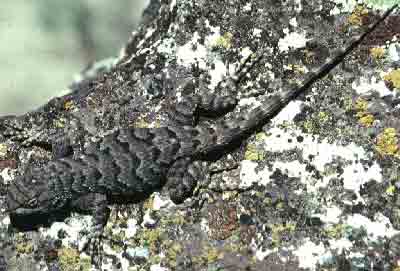
Sceloporus occidentalis
(Western Fence Lizard)
Key Characteristics
Large spiny scales dorsally
Spiny scales on the posterior of the thighs
Blue patches on the throat and stomach
(more vivid in males)
General Description:
Western Fence Lizards have overlapping, pointed scales that are the source for the common genus name, the Spiny Lizards. These "spiny" scales are more pronounced on Western Fence Lizards than they are on Sagebrush Lizards. Western Fence Lizards have these spiny scales on their backs and limbs, even on the posterior of their legs, which is not the case with Sagebrush Lizards the other Sceloporus species (they have granular scales on the posterior of their thighs), (Nussbaum et al. 1983). Western Fence Lizards can have a range of dorsal ground coloration that is usually some shade of gray, tan or brown. These lizards can lighten or darken the ground color to some degree, and some individuals are black. The ground color is broken by a series of wavy dark transverse lines or blotches. These blotches are more obvious on light colored lizards (females and juveniles are usually a lighter color than males). Male Western Fence Lizards vary in coloration from females and juveniles in another ways as well; they have more distinct belly patches and a throat patch, which are usually bordered by black markings, and they have scattered blue or green scales dorsally (Storm and Leonard 1995). Females and juveniles lack the throat patch and the belly patches are either less prominent or absent. The posterior of the limbs are colored orange or yellow with black lines. This coloration helps distinguish Western Fence Lizards from Sagebrush Lizards because the later lack the orange-yellow color on the posterior of the limbs.
Western Fence Lizards are medium-sized lizards that are larger than their Idaho congener the Sagebrush Lizard. Western Fence Lizards can attain sizes of around 99 mm snout-vent length (3.9 in.) and 213 mm (8.4 in.) total length (Storm and Leonard 1995). The total length is comprised of a tail that is approximately 1.5 times the snout-vent length (Nussbaum et al. 1983), unless of course the tail is regenerating, as these lizards will readily lose their tail.
Western Fence Lizards mate in the spring laying 3-17 eggs (usually 8) between June and July, which hatch in August (Nussbaum et al. 1983). Juveniles are similar in appearance to adult females.
Habitat:
Western Fence Lizards occupy a variety of habitats that usually have a vertical component, and they avoid dense, moist forests and low flat desert valleys (Nussbaum et al. 1983). In western Idaho, they are usually found in association with rock outcroppings, talus slopes and cliff faces, they can however also be found in open forested areas on rocks, logs and trees.
Idaho Distribution:
Western Fence Lizard are distributed in Idaho across the lower, western half of the state. From central Idaho, south through Nevada, and west to Pacific Coast.
Diet:
Eats beetles, flies, caterpillars, ants, other insects, and spiders.
Ecology:
Hibernates/aestivates. Inactive during cold weather. Duration of inactive period varies with local climate. Emerges from hibernacula in late winter or early spring (in Northwest, length of activity varies greatly according to local climatic conditions, but is generally from February to October). Adult males defend home range during breeding season (in California, seasonal home range is generally much less than 0.01 ha). Predators include raptors, snakes, and shrews.
Reproduction:
Female lays eggs from April or May to June or July. Clutch size varies from 3-17 eggs; largest females produce largest clutches. Female may produce more than 1 clutch/yr in some areas (in Northwest, females are thought to lay single clutch). Eggs hatch in about 2 mo. Adults first breed in spring of second year.
Conservation:
|
Status: |
Unprotected nongame species |
|
Global Rank: |
G5 |
|
State Rank: |
S4 |
Important State References:
Diller, L.V. and D.R. Johnson. 1982. Ecology of reptiles in the Snake River Birds of Prey Area. USDI Bur. Land Manage. Snake River Birds of Prey Research Project, Boise. 107pp.
Species description, key characteristics and original work by John Cossel Jr. © 1997
Species ecological information from Groves et al. ©1997.
Original images provided by Charles R. Peterson.© 1998
Design and Optimization by Ean Harker©1999, 2000.
DAI layout by Stephen Burton, and Mike Legler © 1999.
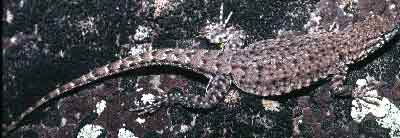
Uta stansburiana
(Side-blotched Lizard)
Key Characteristics
Small granular scales
Gular fold
Dark blotch behind forelimbs
General Description:
Side-blotched Lizards are petite lizards that are covered with fine granular scales with the exception of the tail, which has scales that are slightly keeled. Two other morphological characteristics of this species are the gular fold on the throat and the large interparietal scale on the top of the head. The third eye (the parietal eye) is easily located in the center of this scale. The dorsal ground color of Side-blotched Lizards is generally a light shade of gray or tan that is sprinkled with both light and dark colored spots. Some of these spots may be light blue on both sexes, and males often have orange sides and neck, particularly during the breeding season. The ventral coloration of Side-blotched Lizards is more subdued, being a light cream or white. The most obvious marking is the namesake of these lizards, and is the dark bluish-black spot that is present on the sides behind the forelimbs. These spots are more distinct in males, but females and juveniles generally have the marking to some degree. Overall, females and juveniles are less vividly colored than their male counterparts.
Side-blotched Lizards are the smallest lizard species in Idaho. Adults only attain snout-vent length sizes of around 54 mm (2 in.) and total lengths of 130 mm (5 in.), (Storm and Leonard 1995) with their tails being up to 1.5 times their snout-vent length (Nussbaum et al. 1983).
Side-blotched Lizards mature early and may lay two clutches of eggs during one breeding season (up to three clutches in some parts of their range) (Behler and King 1979, Nussbaum et al. 1983). The clutches usually contain 2-5 eggs, which are laid during late April or May. The eggs hatch in about two months (Storm and Leonard 1995). Juveniles look like adult females (except that neonates seem to have large heads for their body size).
Habitat:
Side-blotched Lizards inhabit arid to semi-arid regions that are vegetated with desert shrubs or pinion-juniper trees (Nussbaum et al. 1983). These lizards can be found on a variety of substrates such as sand, gravel or loess and there may often be a rock component to the area. In Idaho, Side-blotched Lizards often share the same rocky habitats with Western Fence Lizards.
Idaho Distribution:
Side-blotched Lizards in Idaho are found across the southwestern portion of the state. From Washington, south to tip of Baja California and northern Mexico, and east to western Colorado and Texas.
Diet:
Eats insects (frequently Hymenoptera, Coleoptera, Hemiptera, Orthoptera), spiders, scorpions, mites, and ticks. Adult males sometimes cannabalize young. In Idaho, diet may include flies, ants, and caterpillars.
Ecology:
Hibernates/aestivates. Active from March to November in northern range; active all year in southern range. May aggregate during hibernation in some areas. In Idaho, species is strictly diurnal; may be active during morning and evening during hot, summer months. In Colorado study, home range size was estimated at 0.01-0.03 ha, and population density was estimated at 25-44 adults/ha. Density ranged from 11-285 individuals/ha in 7 sites in California, Nevada, Oregon, and Washington (mean density was 60/ha and 78/ha, in 2 consecutive years). Most abundant lizard in Idaho; predators include night snakes, striped whipsnakes, and raptors.
Reproduction:
Breeding season lasts longer in southern range than in north. Female lays 1-2 clutches of 3.75 eggs (Idaho average) in March-August. Young reach sexual maturity in 1-2 yr.
Conservation:
|
Status: |
Unprotected nongame species |
|
Global Rank: |
G5 |
|
State Rank: |
S5 |
Important State References:
Bakewell, G., J.M. Chopek, and G.L. Burkholder. 1983. Notes on reproduction of the side-blotched lizard Uta stansburiana stansburiana in southwest Idaho. Great Basin Natur. 43:477-482.
Species description, key characteristics and original work by John Cossel Jr. © 1997
Species ecological information from Groves et al. ©1997.
Original images provided by Charles R. Peterson ©1998
Design and Optimization by Ean Harker©1999, 2000.
DAI layout by Stephen Burton, and Mike Legler © 1999.
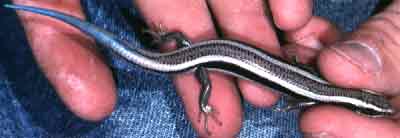
Eumeces skiltonianus
(Western Skink)
Key Characteristics
Smooth, cycloid scales
Elongate body
Tail often has a bluish color
(more vivid in juveniles)
Light colored lines on a brown ground color
General Description:
Western Skinks are unique among Idaho lizards in that they are covered with smooth, cycloid scales. These scales give Western Skinks a very glossy appearance. Western Skinks have a somewhat long, slim body and a tail that may be a bright blue color. The tail coloration fades to a gray in adulthood, but usually retains some hint of blue. Western Skinks readily autotomize (lose) their tails, and the bright blue coloration found on juveniles may add to the wriggling tail's distractability. The rest of the body is also handsomely colored with stripes of tan, cream and brown. There is a wide vertebral stripe (runs down the middle of the back), which is usually a tan color, but on juveniles, it is often a very dark brown. The vertebral stripe is bordered on either side by dark (black or brown) stripes (these are not apparent on juveniles, as their vertebral stripe is the same color). The next stripes are cream or light tan in coloration and extend dorsolaterally (between the back and sides). These light colored stripes are bordered on the sides by a fairly wide dark brown stripe. Finally, there is one more lateral (side) stripe on each side that is a light cream color, this blends into the light ventral coloration. All of the stripes originate on the head and extend onto the base of the tail (Stebbins 1985). Males may have an orange tinge on their chin and sides of their head during breeding season (Nussbaum et al. 1983).
Western Skinks are small to medium-sized lizards that can attain snout-vent length sizes of 76 mm (3 in.) and 201 mm (7.9 in.) total length (Storm and Leonard 1995).
There is relatively little known about the reproduction of Western Skink populations in the Northwest. However, based on information of Western Skinks in Utah, they probably mate in May or June, and deposit 2-6 eggs in July (Nussbaum et al. 1983). Based on the observation of recently hatched neonates in August, we can assume that the eggs hatch sometime during August and perhaps September. One note of interest concerning the reproductive habits of Western Skinks is that the females display parental care for the eggs. The female will stay with the eggs, protecting them against predators, repairing the nest and possibly providing additional heat by basking and then returning to the nest (Behler and King 1979), (Nussbaum et al. 1983), (Storm and Leonard 1995).
Habitat:
Western Skinks are generally found in a variety of habitats including pinion-juniper forests, grassy areas, desert shrub, talus slopes and canyon rims (Storm and Leonard 1995). Stebbins (1985) mentions that they are often found in areas associated with water (rocky, brushy areas along streams). I have encountered Western Skinks at sites that did have water nearby, but as Stebbins states (and based on my own experiences) this isn't a requirement.
Idaho Distribution:
Western Skinks can be found across much of Idaho, with the exception of the southwestern corner, and the southeastern edge of the state. Ranges from south-central British Columbia to southern Baja California, and east to western Montana, Idaho, eastern Utah, north-central Arizona, and southern Nevada. Also found on some islands off coast of California and Baja California. Isolated populations exist in California and Nevada.
Diet:
Feeds on variety of insects (crickets, beetles, grasshoppers, flies, etc.), spiders, and earthworms.
Ecology:
Hibernates/aestivates. Inactive in cold, winter weather; duration of inactive period varies with local climate. Secretive; ecology and life history are not well known. In Idaho, night snakes, striped whipsnakes, and raptors are predators.
Reproduction:
In Utah, mating occurs in May or June, female lays 2-6 eggs in July, and eggs hatch in August. Female guards eggs and stays with hatchlings until they disperse from nest.
Conservation:
|
Status: |
Unprotected nongame species |
|
Global Rank: |
G5 |
|
State Rank: |
S5 |
Species description, key characteristics and original work by John Cossel Jr. © 1997
Species ecological information from Groves et al. ©1997.
Original images provided by Charles R. Peterson, William R. Radke.© 1998
Design and Optimization by Ean Harker©1999, 2000.
DAI layout by Stephen Burton, and Mike Legler © 1999.
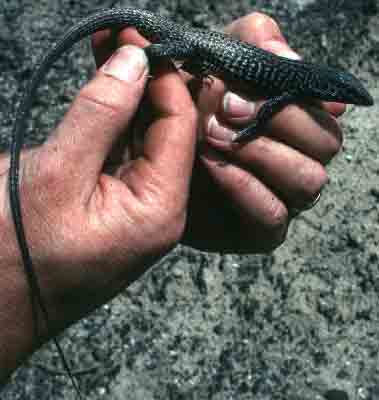
Cnemidophorus tigris
(Western Whiptail)
Key Characteristics
Triangular head with a pointed snout
Granular scales dorsally
Long tail (more than twice length of body)
with keeled scales
Quadrangular ventral scales arranged in 8 rows
General Description:
Depending on the individual, Western Whiptails may appear to have a light ground color that is marked by a dark reticulated (network) pattern, or they may appear to have a dark ground color that is marked by numerous light colored spots. Regardless, there is always a striped pattern that is apparent (even if faded or obscure). The four stripes are a light tan, gray or cream color and extend dorsolaterally from the base of the head towards the tail. The stripes are most prominent in juveniles, and they tend to fade posteriorly in adults. The previously described pattern of contrasting spots and markings extends onto the base of the tail, but the color darkens towards the tip, becoming a solid bluish-gray. Juveniles have more of a bluish tinge to their tail coloration (although not as vivid as with Western Skinks). Western Whiptails have fine, granular scales dorsally, and large rectangular scales arranged in 8 rows ventrally. The lower limbs of these lizards have a distinct scalation, being covered anteriorly with large, smooth scales that contrast with the granular scales elsewhere on the limbs. In fact, the genus name loosely translated means "bearing armored legs".
Western Whiptails are medium-sized lizards, and can reach lengths comparable to the Longnose Leopard Lizard and the Mojave Black-collared Lizard. However, due to their long slender body and whip-like tail Western Whiptails are not as massive as the other two species of lizard. Western Whiptails can attain snout-vent lengths of 112 mm (4.5 in.) and 330 mm (13 in.) in total length (Storm and Leonard 1995). The long tail of the Western Whiptail can be more than twice the snout-vent length if it is unbroken (Nussbaum et al. 1983). There is a fair chance that a Western Whiptail may be encountered with a tail that is regenerating, as they will readily lose their tail to predators and would be captors.
Western Whiptails mate in the spring, laying 1-4 eggs in June or July, which in turn hatch in August (Storm and Leonard 1995). The juveniles resemble the adults but are more vividly colored (including the tail, which is more blue in coloration).
Habitat:
Western Whiptails are found in desert regions that have moderate to limited amounts of vegetation such as sagebrush or shadscale. The substrate may range from sand, gravel, hardpan or loess, but regardless of type, burrows seem to be an important component. Rocks on the other hand, don't seem to be necessary like they are to some other Idaho lizard species.
Idaho Distribution:
Western Whiptails are restricted to the southwestern portion of the state. From Oregon and Idaho, south to southern Baja California and northern Mexico, and from California east to Colorado and Texas.
Diet:
Eats insects, spiders, scorpions, and lizards. Known to eat Lepidopterans, crickets, grasshoppers, and beetles.
Ecology:
Hibernates/aestivates. Active from April to September in northern range. Juveniles may be active on warm days in winter in southern range. In Idaho, individuals are active in early spring (mid-April), aestivate during middle part of summer, and are active again during late summer and early fall. When inactive, individuals remain in underground burrows dug by rodents or lizards. Colorado study determined that adult home range averaged about 0.10-0.13 ha; population density was about 17/ha. In Idaho, heavy predation results from active foraging behavior; tail breakage exceeds 50% in large adults in some populations. Individuals in Idaho are larger than those in more southern areas.
Reproduction:
Female produces 1 clutch/yr in northern range, 2 (perhaps 3) in south (1 clutch in Idaho). Clutch size is smaller in north than in south (average 2.7 in Idaho). Young reach sexual maturity in 20-23 mo in Idaho and Colorado, and probably at end of first year in far southern range.
Conservation:
|
Status: |
Unprotected nongame species |
|
Global Rank: |
G5 |
|
State Rank: |
S4 |
Important State Reference:
Burkholder, G.L. and J.M. Walker. 1973. Habitat and reproduction of the desert whiptail lizard Cnemidophorus tigris in southwestern Idaho at the northern part of its range. Herpetologica 29:76-83.
Species description, key characteristics and original work by John Cossel Jr. © 1997
Species ecological information from Groves et al. ©1997.
Original images provided by Charles R. Peterson, William P. Leonard, and John Cossel Jr.© 1998
Design and Optimization by Ean Harker©1999, 2000.
DAI layout by Stephen Burton, and Mike Legler © 1999.
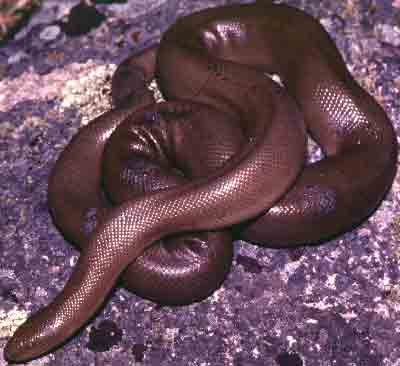
Charina bottae
(Rubber Boa)
Key Characteristics
Smooth scales
Small eyes with vertical pupils
Blunt tail
Small spurs near cloaca
(difficult to see on females)
Small chin shield scales
General Description:
Rubber Boas are generally one solid color dorsally, (dark-brown, tan or olive-brown), and a lighter contrasting color ventrally (yellow or cream). Rubber Boa scales are small and smooth, and the skin is somewhat loose (this causes these snakes to appear and feel rubbery) (Koch and Peterson 1995). The head gradually tapers to the body and the tail also gradually tapers, ending in a blunt stub. This gives these snakes the appearance of having two heads. In fact, when threatened, Rubber Boas will hide their head in their coils and stick their tail in the air to direct attention from the head, occasionally even striking with their tail. To add to the disguise, Rubber Boas have small eyes that are hard to distinguish from a distance. The eyes have a copper or bronze colored iris and a vertical pupil.
Rubber Boas are medium-sized snakes (Koch and Peterson 1995), generally reaching sizes of around 600 mm (2 ft.) but can attain sizes of up to 830 mm (33 in.), (Storm and Leonard 1995). Rubber Boas are slow moving, and seem to lack many of the tactics used by other faster snakes to obscure their speed and position (see the account for the Striped Whipsnake).
Rubber Boas are typical boas in that they are viviparous (give birth to live young). They mate in April or May and then give birth to 2-8 young between August and November (Storm and Leonard 1995). Normally, Rubber Boas are secretive and seldom encountered in the open. However, female Rubber Boas can sometimes be found basking out in the open. Juvenile Rubber Boas resemble adults morphologically, but they are often lighter in coloration (sometimes almost pinkish) (Koch and Peterson 1995).
Habitat:
Rubber Boas can be found in a variety of habitats, ranging from desert shrub to open pine forest. Often, there is a water source nearby and rocks, woody debris or leaf litter that these snakes use for cover.
Idaho Distribution:
In Idaho, Rubber Boas can be found in appropriate habitat across the entire state. From southern British Columbia, south to southern California, central Nevada and southern Utah, and east to north-central Wyoming and western Montana. Distribution is spotty.
Diet:
Eats mostly mice and shrews, but may also prey on lizards, snakes, and small birds.
Ecology:
Hibernates/aestivates, Nocturnal/crepuscular. Active from March to November. Kills prey by constriction. Wards off predators by releasing potent musk from anal glands.
Reproduction:
Female bears 2-8 live young from August to November, depending on range (in Northwest, young are born in September).
Conservation:
|
Status: |
Unprotected nongame species |
|
Global Rank: |
G5 |
|
State Rank: |
S5 |
Design optimization and revision by Ean Harker ©1999, 2000
Original images provided by Charles R. Peterson and John Cossel Jr. ©1998
Original work by John Cossel Jr. © 1998
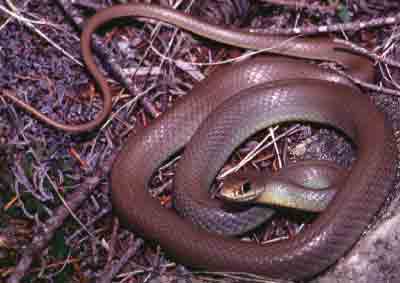
Coluber constrictor
(Racer)
Key Characteristics
Large eyes with round pupils
Solid color dorsally on adults
(blotched pattern on young)
Smooth scales
Fast moving
General Description:
Racers are, as their name implies, fast and sleek snakes. Their speed contrasts with the slow moving Rubber Boa. Besides their rate of movement, other Racer characteristics that contrast with Rubber Boas, are their large eyes and round pupils. Racers are visual predators, relying on visual cues to help them identify prey. In fact, Racers will sometimes raise their head and upper body while foraging. Racers are generally a solid color both dorsally (green, tan or blue-gray) and ventrally (yellow to cream). These snakes are unusual among Idaho snake species because juveniles are colored differently than adults. Juveniles have a light gray ground, a series of brown saddles dorsally and blotches along their sides (Stebbins 1985). As the young snakes age, these dark markings fade from the tail towards the head, and the ground color becomes green, gray or tan. Juvenile Racers could be mistaken for young Gopher Snakes, but the smooth scales help distinguish Racers from Gopher Snakes, which have keeled scales.
Racers are medium-sized snakes, which in the Pacific Northwest reach total lengths of around 120 cm (48 in.) (Storm and Leonard 1995). However, in other parts of their range, Racers can get as large as 196 cm (77 in.) (Behler and King 1979).
Racers mate in May, and lay 3-6 eggs (but as many as 28 in parts of their range) in June or July (Behler and King 1979, Nussbaum et al. 1983). An interesting note is that Racers will sometimes lay their eggs communally with other species (Nussbaum et al. 1983). The eggs generally hatch in August (Storm and Leonard 1995), and the young resemble the adults in form but are colored differently (as described above).
Habitat:
Racers can be found in a variety of habitats ranging from open forests to rocky or brushy desert areas. They are often encountered along desert/agricultural interfaces, where they can take advantage of the higher density of prey items such as rodents, insects and amphibians. In arid habitats, Racers will include lizards in their diet as well.
Idaho Distribution:
Racers can be found across most of Idaho and are absent only from the northernmost portion of the state. From southern British Columbia, east to Maine, and south across the U.S. to southern Florida, Guatemala, and southern California.
Diet:
Diet typically includes small mammals, birds, reptiles, amphibians, and large insects.
Ecology:
Inactive during cold weather; in central U.S., hibernates from November to March. In Idaho, adults emerge from den in late April to early May, and return to distinct hibernacula by October; hibernates with other snakes. In Michigan and other cold-winter areas, adults are active on bright overcast or sunny days in summer, and only on sunny, warm days in spring and fall. Adults hide underground, in crevices, or under surface cover when inactive. Home range size has been estimated at 1.4 ha for nongravid females in Utah, and about 10 ha in Kansas. In Utah study, population density was estimated at 0.65/ha. Separate studies estimated adult annual survivorship at 79% in Utah, 62% in Kansas, and 54% in Michigan. Individuals sometimes nest communally, and may climb shrubs and small trees.
Reproduction:
Egg-laying peaks in early to mid-June in southern Michigan, and late June or early July in Utah, Colorado, and Idaho. Female lays clutch of 3-28 eggs (3-6 in Idaho). Average clutch size is higher in eastern range than in west; mean clutch size is about 6 in Utah, 12 in Kansas, and 15 in Michigan. Eggs hatch in 6-9 wk. Females become sexually mature in 3 yr in Utah, 2-3 yr in Kansas, 2 yr in Michigan.
Conservation:
|
Status: |
Unprotected nongame species |
|
Global Rank: |
G5 |
|
State Rank: |
S5 |
Design optimization and revision by Ean Harker ©1999, 2000
Original images provided by Charles R. Peterson ©1998
Original work by John Cossel Jr. © 1998
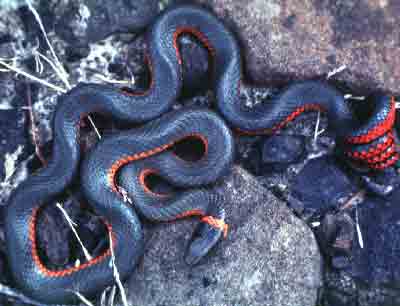
Diadophis punctatus
(Ringneck Snake)
Key Characteristics
Smooth scales
Solid gray dorsal coloration
Vivid yellow, orange and/or red coloration ventrally
(often forming a ring on the neck)
Round pupils
General Description:
Ringneck Snakes are easy to identify because of their vivid ventral coloration, which often starts as yellow anteriorly and grades to red posteriorly. The bright ventral color is marked by numerous black spots, hence the specific epithet punctatus, which means punctured or perforated. The common name refers to the yellow ventral coloration that extends up around the neck forming a ring. However, in southeastern Idaho, you can encounter individuals that lack the neck ring. The yellow ventral coloration also extends up from the chin, onto the labial (lip) scales. The dorsal coloration of these snakes is much more subdued, being a slate gray that can vary in darkness among individuals. Ringneck Snakes have smooth scales, and round pupils, but these characteristics probably won't have to be referred to when identifying these snakes.
Ringneck Snakes are relatively small snakes, typically reaching sizes of about 50 cm (20 in.), but they can attain sizes of up to 75 cm (30 in.) (Storm and Leonard 1995).
Ringneck Snakes mate in spring, lay a clutch that ranges from 1 to 10 eggs (with usual numbers being 3 or 4), and these eggs then hatch in late summer (Storm and Leonard 1995). The young resemble the adults, but the gray dorsal coloration is often quite dark (almost black) (Storm and Leonard 1995).
Habitat:
Ringneck Snakes can be found in forested, brushy areas or open hillsides that have rocks or other debris for them to hide in and they may use microhabitats that are moist (Storm and Leonard 1995).
Idaho Distribution:
In Idaho, Ringneck Snakes can be found in disjunct areas over much of the state. From Pacific to Atlantic coasts, and from Nova Scotia, Minnesota, Colorado, Idaho, and Washington, south across U.S. to Florida Keys and northern Baja California. Distribution is spotty in western states.
Diet:
Eats earthworms, slugs, other small invertebrates, and small salamanders, frogs, lizards, and snakes.
Ecology:
Nocturnal. Hibernates/aestivates. Inactive in winter in most areas. In Idaho, probably departs den in May, and returns in September or October. Secretive; hides underground, in logs, or under surface cover during day. Kansas study estimated population density at 700-1800/ha; distances between recaptures averaged 80 m (range 0-1700 m), and home range had maximum dimension of about 140 m. Communal nesting is common. Species is thought to be venomous, but not harmful to man. Although few records exist for Idaho, species is probably more common than it appears.
Reproduction:
Lays clutch of 1-18 eggs, usually in June or July (in the Northwest, female deposits about 3 eggs annually in July, in stabilized talus or rotting log). Female in southern range may possibly lay 2 clutches. Eggs hatch in about 8 wk. Adults reach sexual maturity in 2-3 yr.
Conservation:
|
Status: |
Unprotected nongame species |
|
Global Rank: |
G5 |
|
State Rank: |
S1 |
Species description, key characteristics and original work by John Cossel Jr. © 1997
Original images provided by Charles R. Peterson © 1997
Design and Optimization by Ean Harker©1999, 2000.
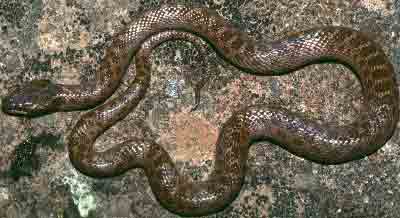
Hypsiglena torquata
(Night Snake)
Key Characteristics
Bronze/copper eye color, with a vertical pupil
Smooth scales
Small size
Tan ground color with brown saddles/blotches
General Description:
Night Snakes are smooth scaled snakes with striking bronze/copper colored eyes that have vertical pupils. These features help distinguish them from Gopher Snakes, which are similarly colored but have keeled scales and round pupils. Night Snakes have a dorsal coloration that consists of a tan ground color that is marked by contrasting brown saddles and lateral (side) spots. The darker brown color also extends from the eyes onto the neck and forms a blotch at the base of the head. This dark eye-line contrasts with the light (white or cream) colored labial area. Night Snakes have a solid, pearly-white ventral coloration that is usually iridescent. Night Snakes are mildly venomous (although not dangerous to humans), and when they are threatened they may coil their body and thrust the coils towards the offender. While in this defensive posture, the head is flattened into a triangular shape.
Night Snakes are small snakes, generally less than 61 cm (24 in.) in total length (Storm and Leonard 1995).
Night Snakes, like most other snakes from Idaho, mate in the spring and lay 3-9 eggs that hatch later in the summer (Storm and Leonard 1995). The juveniles resemble the adults.
Habitat:
Night Snakes are nocturnal, making them difficult to find. They can be encountered by turning objects or during the night on desert roads. These snakes inhabit desert lowlands that generally have a rocky component, although they can be found in areas lacking rocks, provided there are rodent burrows (Storm and Leonard 1995).
Idaho Distribution:
In Idaho, Night Snakes can be found in the southern portion of the state, and northward along the Snake River to Lewiston. From southern British Columbia, Idaho, Colorado, and Kansas, south to southern Baja California and mainland Mexico.
Diet:
Eats mainly lizards and lizard eggs; may also eat small snakes, frogs, insects, and salamanders. Study conducted in southwestern Idaho found diet commonly consisted of side-blotched lizards, their eggs, and anurans.
Ecology:
Nocturnal/crepuscular. Hibernates/aestivates. Most active from April to October in Texas and Pacific Northwest. Major peak in activity occurs in early June in Idaho; activity may be restricted to relatively cool nights. When inactive, generally found under rocks, in crevices, or underground (in Idaho, found under rocks in spring but not in summer). Known to be mildly venomous. Southwestern Idaho study found that females are 50% longer and 3 times the body mass of males.
Reproduction:
Female lays clutch of 2-9 eggs from April to August, depending on range (late June or July in Idaho). Eggs hatch in 7-8 wk. Males may reach sexual maturity in 1 yr.
Conservation:
|
Status: |
Unprotected nongame species |
|
Global Rank: |
G5 |
|
State Rank: |
S3 |
Important State References:
Diller, L.V. and R.L. Wallace. 1986. Aspects of the life history and ecology of the desert night snake, Hypsiglena torquata deserticola: Colubridae, in southwestern Idaho. Southwest. Natur. 31:55-64.
Species description, key characteristics and original work by John Cossel Jr. © 1997
Original images provided by Charles R. Peterson © 1997
Design and Optimization by Ean Harker©1999, 2000.
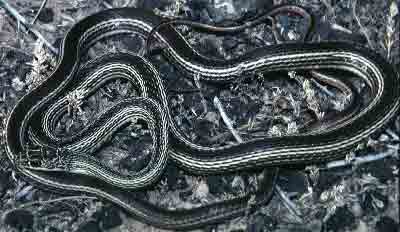
Masticophis taeniatus
(Striped Whipsnake)
Key Characteristics
Large eyes with round pupils
Long, slender body
Light stripes contrasting with a dark ground color
Rapid moving
General Description:
Striped Whipsnakes are long, slender snakes that have prominent eyes with round pupils. Like Racers, Striped Whipsnakes rely on visual cues to aid them in locating prey, and they will elevate their head to gain a better view. Striped Whipsnakes have smooth scales and charcoal to black dorsal ground color. The ground color is broken by light-colored lateral stripes, and the head has both light and dark markings. Striped Whipsnakes have a light ventral coloration (white to cream), that gains a pinkish hue posteriorly and on the tail. These snakes are often seen fleetingly, due to their speed and the optical illusion created by their striped pattern. The stripes mask the motion and speed of the snake until the tail disappears in the brush. If captured, these snakes are aggressive and usually will not hesitate to bite. Perhaps this behavior is the source of their generic name Masticophis, which means biting/chewing snake.
In our area, Striped Whipsnakes are one of the longest snake species, although not the largest, as Gopher Snakes are heavier and may reach up to 170 cm (Charles R. Peterson, pers. com. 1998). Adult Striped Whipsnakes can reach lengths of over 1.5 m (5 ft.) (Storm and Leonard 1995).
Striped Whipsnakes mate in the spring and then lay 3-10 eggs, which hatch in late summer early fall (Storm and Leonard 1995). Juvenile Striped Whipsnakes resemble adults.
Habitat:
Striped Whipsnakes are found in desert areas with brush (sage, greasewood, etc.) or grass, and I often find them in areas that have a rock component.
Idaho Distribution:
In Idaho, Striped Whipsnakes are restricted to the southwest and south-central portions of the state. From Washington through Great Basin to New Mexico, Texas, and central Mexico.
Diet:
Young eat mainly lizards. Adults eat mostly lizards and snakes, but may also eat small mammals, insects, and small birds.
Ecology:
Terrestrial and arboreal. Hibernates/aestivates underground or in deep crevices during cold weather. Little information is available for the Northwest. Active from late March to October in Utah; hibernation begins in September or October. In Utah study, population density was determined to be about 0.1-0.3/ha (excluding snakes less than 1 yr old). Individuals hunt with heads held high off ground. Some individuals live 10-20 yr.
Reproduction:
Mating occurs in April and May. Female lays clutch of 3-12 eggs, from June to July depending on range. Eggs hatch in 50-57 days (August or September). Females reach sexual maturity in 2-3 yr.
Conservation:
|
Status: |
Unprotected nongame species |
|
Global Rank: |
G5 |
|
State Rank: |
S4 |
Important State References:
Diller, L.V. and D.R. Johnson. 1982. Ecology of reptiles in the Snake River Birds of Prey Area. USDI Bur. Land Manage. Snake River Birds of Prey Research Project, Boise. 107pp.
Design optimization and revision by Ean Harker ©1999, 2000
Original images provided by Charles R. Peterson and John Cossel Jr. ©1998
Original work by John Cossel Jr. © 1998
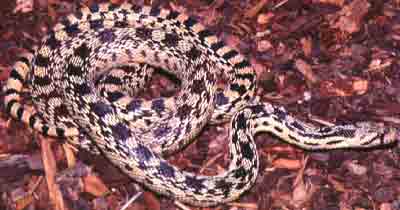
Pituophis catenifer
(Gopher Snake)
Key Characteristics
Keeled scales
Dark blotches dorsally that contrast with light ground color
Round pupils
Dark eye stripes
Large size
General Description:
Gopher Snakes are light colored dorsally (white to beige), with contrasting dark saddles and blotches (brown to black). Gopher Snakes have a light ventral coloration that may have a dark checkered pattern. There is a dark line that extends across the snout and on past each eye. Gopher Snakes have keeled scales, this helps distinguish young Gopher Snakes from juvenile Racers, which have smooth scales. Gopher Snakes have round pupils, which is different from both Night Snakes and Western Rattlesnakes. These two species could be confused for Gopher Snakes, but both have vertical pupils. As with any species, there are color mutations that can occur in Gopher Snakes. I encountered such a snake in Toule County, Utah. This snake had the light ground color but lacked the blotches and dark markings.
Gopher Snakes are the largest snake species in Idaho, reaching lengths of up to 170 cm (>67 in.) (Charles R. Peterson pers. com. 1998), but they can be longer in other parts of their range; over 2.5 m (~100 in.) (Stebbins 1985). However, Western Rattlesnakes may have the largest mass.
Gopher Snakes mate in the spring, laying 3-8 eggs, neonates usually appear in September or October (Storm and Leonard 1995) and the young resemble adults.
Habitat:
Gopher Snakes may be the most frequently encountered snake in Idaho. They can be found in a variety of habitats ranging from desert shrub lands to low mountain areas. Like the Racer, Gopher Snakes are also frequently found in agricultural areas, utilizing the abundant prey available.
Idaho Distribution:
In Idaho, Gopher Snakes can be found in appropriate habitat across most of the state, with the exception of the northern portion. From southwestern Canada south to northern Mexico.
Diet:
Eats rodents, rabbits, birds and their eggs, and occasionally lizards and insects (latter 2 items are more common in diet of juveniles than adults). In southwestern Idaho study, primary prey included rabbits, ground squirrels, voles, kangaroo rats, and several species of mice.
Ecology:
Terrestrial, fossorial, and arboreal. Often forages underground. Generally diurnal, but may be active at night in hot weather. Hibernates/aestivates. Active from about April to October in northern range, and from March to November in northern Texas. Idaho study determined that males emerge from hibernation prior to females. Utah study estimated home range at 1-2 ha. Idaho and Utah study estimated population density at 0.3-1.3/ha. May nest communally. In Idaho, birds of prey, especially Red-tailed Hawks, are important predators.
Reproduction:
In Idaho, mating occurs in April and May. Female lays 1-2 clutches of an average of 7 eggs. Eggs hatch in 50-79 days. Utah study found that males reach sexual maturity in 1-2 yr, females in 3-5 yr.
Conservation:
|
Status: |
Unprotected nongame species |
|
Global Rank: |
G5 |
|
State Rank: |
S5 |
Important State References:
Diller, L.V. and D.R. Johnson. 1988. Food habits, consumption rates, and predation rates of western rattlesnakes and gopher snakes in southwestern Idaho. Herpetologica 44:228-233.
Design optimization and revision by Ean Harker ©1999, 2000
Original images provided by Charles R. Peterson and John Cossel Jr. ©1998
Original work by John Cossel Jr. © 1998
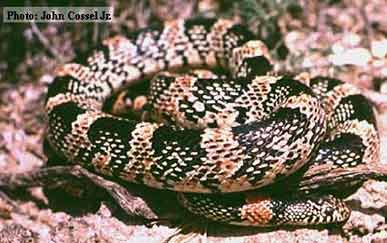
Rhinocheilus lecontei
(Longnose Snake)
Key Characteristics
Black saddles separated by reddish-orange
bars and white speckles on all
Long snout with lower jaw recessed
Round pupil
Caudal scales single
General Description:
Longnose snakes are easy to recognize with their alternating black and orangish-red saddles that are flecked with cream spots. The only other snake that might have this coloration is the Western Ground Snake, and they generally lack the light colored spots. Another characteristic of Longnose Snakes that is unique among Idaho colubrids, is their caudal scales that are arranged in a single row (Nussbaum et al. 1983). Longnose snakes have round pupils and as their common name suggests, a long pointed snout. The lower jaw is shorter than the upper jaw (Nussbaum et al. 1983), which adds to the appearance of a long nose. Longnose snakes have the curious defense behavior of bleeding from the cloaca. This does not always occur, and the more frequent response, is to coil their body and to vibrate their tail.
Longnose Snakes are medium-sized snakes usually less than 70 cm (~27 in.) in total length (the record is 104 cm) (Nussbaum et al. 1983).
Based on information from southwestern populations, it is believed that Longnose Snakes lay 5-8 eggs in the early summer, which hatch in late summer or early fall (Nussbaum et al. 1983), and young resemble adults.
Habitat:
Longnose Snakes are found in desert lowland areas that have sandy or loose soil and numerous burrows.
Idaho Distribution:
In Idaho, Longnose Snakes can be found in the southwestern desert regions of the state. They may also occur south of Burley, Idaho. From northern California, southern Idaho, southeastern Colorado, and southwestern Kansas, south to central Mexico.
Diet:
Eats lizards and their eggs, small snakes, small mammals, and sometimes birds (in Idaho, eats primarily lizards and mice).
Ecology:
Hibernates/aestivates. Active from about April to September in northern range. Furtive; abundance indicated by frequency of remains found in hawks' nests (raptors are common predator.) Little is known about Northwest ecology or life history.
Reproduction:
Female lays 1 clutch (possibly 2) of 5-8 eggs, from June-August. Eggs hatch in 2-3 mo.
Conservation:
|
Status: |
Unprotected nongame species |
|
Global Rank: |
G5 |
|
State Rank: |
S3 |
Important State Reference:
Diller, L.V. and R.L. Wallace. 1981. Additional distributional records and abundance of three species of snakes in southwestern Idaho. Great Basin Natur. 41:154-157.
Design optimization and revision by Ean Harker ©1999, 2000
Original images provided by Charles R. Peterson and John Cossel Jr. ©1998
Original work by John Cossel Jr. © 1998
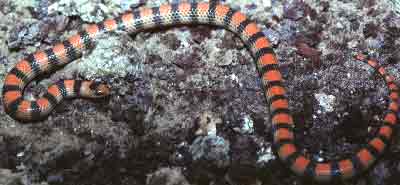
Sonora semiannulata
(Western Ground Snake)
Key Characteristics
Color variable (may be solid, striped or banded)
Smooth scales
Round pupils
Small size
General Description:
Western Ground Snakes are variable in coloration, occuring with banded, striped or nearly solid dorsal patterns. The different color forms (morphs) can even be found in the same population (Jonathon M. Beck, pers. com. 1995). The pattern I have mainly encountered consists of a wide, orange dorsal stripe that is broken by black saddles, forming a banded appearance. This banded pattern can occur without the reddish-orange dorsal stripe, causing a light and dark banded coloration. Other color patterns include the reddish-orange dorsal stripe without any black saddles, and nearly solid gray dorsal coloration with only a faint (if any) dorsal stripe. The reddish-orange banded individuals could possibly be confused with Longnose Snakes. However, Western Ground Snakes lack the profuse white speckling and the single caudal scales that Longnose Snakes have. Other morphological features of Western Ground Snakes are smooth scales, round pupils and a slight spine on the tip of the tail (Nussbaum et al. 1983).
Western Ground Snakes are small snakes that only attain maximum lengths of about 38.1 cm (15 in.) (Storm and Leonard 1995).
Little is known about Western Ground Snake reproduction in Idaho (Storm and Leonard 1995). However, in other parts of their range, they mate during both the spring and the fall, and lay clutches of up to 6 eggs in early June to late August (Behler and King 1979). Juvenile Western Ground Snakes resemble adults.
Habitat:
Western Ground snakes are found in arid habitats usually having loose or sandy soil (Storm and Leonard 1995), ranging from rocky areas(talus slopes, canyon rims and outcroppings) to low desert shrub areas. These secretive snakes are seldom encountered, but can occasionally be found by turning debris in the daytime, out in the open near sunset, or on desert roads at night.
Idaho Distribution:
In Idaho, Western Ground Snakes are restricted to the southwestern portion of the state, along the Snake River and surrounding drainages.
Diet:
Eats spiders, scorpions, centipedes, crickets, grasshoppers and insect larvae.
Ecology:
Nocturnal. Hibernates/aestivates. Little is known about ecology or life history in the Northwest. In northern range, most active on warm nights from April to October. Active as early as mid-March in west Texas. Preyed upon by raptors. Shallow grooves on outer sides of rear teeth suggest species is mildly venomous.
Reproduction:
Female lays clutch of 4-6 eggs, usually in June, but as late as August in California. Adults reach sexual maturity in second year.
Conservation:
|
Status: |
Unprotected nongame species |
|
Global Rank: |
G5 |
|
State Rank: |
S3 |
Important State Reference:
Diller, L. V. and R. L. Wallace. 1981. Additional distribution and abundance of three species of snakes in southwestern Idaho. Great Basin Natur. 41:154-15
Design optimization and revision by Ean Harker ©1999, 2000
Original images provided by Charles R. Peterson, Johnathan M. Beck and John Cossel Jr. ©1998
Original work by John Cossel Jr. © 1998
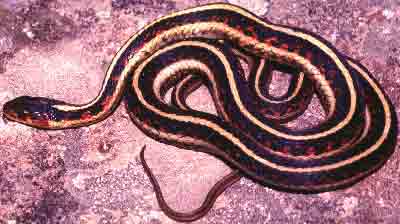
Thamnophis sirtalis
(Common Garter Snake)
Key Characteristics
Three light (yellow to cream) stripes,
usually with red on sides of body
Dorsal stripe with an even margin
Ground color usually black or very dark
Usually 7 labial scales
Round pupils
General Description:
Common Garter Snakes can be distinguished from Western Terristrial Garter Snakes because they usually have 7 upper labial scales, while the later usually have 8 upper labial scales. The 6th and 7th upper labial scales are not enlarged in Common Garter Snakes as they are with Terrestrial Garter Snakes. Common Garter Snakes have dorsal scales that are keeled and their pupils are round. The dorsal coloration of Common Garter Snakes differs from Western Terrestrial Garter Snakes, because the ground color is generally darker (black) and there are usually red checks and markings present laterally and on the rear labial scales. However, there are populations that lack any red coloration. Common Garter Snakes generally have three light stripes like their congeners, but the dark spots, if present, are usually obscured by the dark ground color, and the dorsal stripe has an even margin. The ventral coloration of Common Garter Snakes is a gray with dark markings.
Common Garter Snakes are medium-sized snakes that can attain sizes of up to 132 cm (52 in.) in length (Storm and Leonard 1995).
Common Garter Snakes usually mate after leaving their winter hibernation site (fall breeding may occur) (Charles R. Peterson pers. com. 1998). Multiple males will vie for the attention of reproductive females, and can form mating "snake balls". As a result of this reproductive behavior, several different males may fertilize eggs within the same brood (Storm and Leonard 1995). Young are born between July and September, and brood sizes generally number between 10 and 18 (Storm and Leonard 1995). However, litters of up to 85 young are possible in some portions of their range (Behler and King 1979). Young Common Garter Snakes resemble adults.
Habitat:
Common Garter Snakes are usually found in habitats associated with water, such as streams, rivers, lakes, ponds and marshes. They can also be found in open meadows and coniferous forests (Nussbaum et al. 1983).
Idaho Distribution:
In Idaho, the Common Garter Snake is less common than the Western Terrestrial Garter Snake, but is generally distributed in a similar pattern.
Diet:
Preys chiefly on earthworms, frogs, toads, salamanders, and fishes, less regularly on slugs, leeches, small mammals and birds, and rarely on insects, spiders, and small snakes.
Ecology:
Nocturnal/diurnal; nocturnal activity often occurs during hot weather. Hibernate/aestivates. Hibernates underground, in or under surface cover at times with other snakes species. Active from about March or April through October in northern range and at higher elevations; active season is longer in southern range, to year-round in Florida. Thousands of individuals may aggregate at hibernacula in northern range. Population density estimate in different areas vary from about 10-100/ha. Home range size has been variously reported as 0.8-14 ha. May migrate several km from hibernacula to foraging areas. Individuals will exude musk and fecal material from anus to repel predators.
Reproduction:
Female gives birth to up to 85 young (13-26 on average, commonly 8-12), usually in July or August (earlier in southern range, to early October in north.)
Conservation:
|
Status: |
Unprotected nongame species |
|
Global Rank: |
G5 |
|
State Rank: |
S5 |
Design optimization and revision by Ean Harker ©1999, 2000
Original images provided by Charles R. Peterson and John Cossel Jr. ©1998
Original work by John Cossel Jr. © 1998
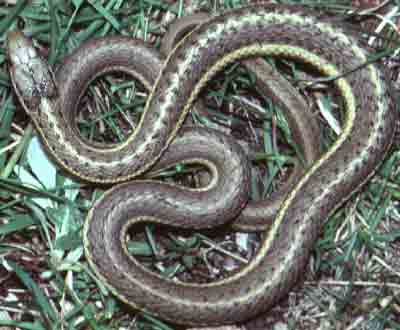
Thamnophis elegans
(Western Terrestrial Garter Snake)
Key Characteristics
Three light (yellow to cream) stripes
Black spots often break the margin of dorsal stripe
Ground color usually a olive or greenish-gray
Usually eight labial scales, with 6th and 7th enlarged
Round pupils
General Description:
Different garter snake species can superficially resemble each other. However, in Idaho, determining which species of garter snake you find is easier than in other parts of the country because we only have 2 species. A standard method used to distinguish between garter snake species is observing scale patterns. Western Terrestrial Garter Snakes generally have 10 lower labial scales, and 8 upper labial scales. The 6th and 7th upper labial scales are usually enlarged (higher than they are wide), due to the presence of glands in the upper jaw. The dorsal scales are keeled and their pupils are round. Western Terrestrial Garter Snakes have a olive to grayish-green ground color dorsally. The ground color is marked by a light colored (yellow to cream) dorsal stripe that extends from the base of the head, along most or all of the body. Generally, there is also a single lateral stripe on each side that is similar in color to the dorsal stripe. The lateral stripes appear to originate on the labial scales, which are similarly colored, and also extend along most or all of the body. In addition to the stripes, there is usually a series of dark spots that are associated with the stripes and they may break the stripe margin. Western Terrestrial Garter Snakes have a gray or beige ventral color that may have dark markings concentrated down the mid-ventral line (Nussbaum et al. 1983). As though garter snake coloration wasn't variable enough, occasionally melanistic (all black) snakes are encountered (Mark Gerber pers. com. 1996, Charles R. Peterson pers. com. 1998).
Western Terrestrial Garter Snakes are medium-sized snakes that can reach up to 107 cm (43 in.) (Storm and Leonard 1995).
Western Terrestrial Garter Snakes generally breed in the spring but fall mating has been reported (Storm and Leonard 1995). Like all garter snakes, they give live-birth rather than laying eggs. Usually 4 to 19 young are born between July and September (Nussbaum et al. 1983).
Habitat:
Western Terrestrial Garter Snakes are often found near water, but as their name implies, they can be found away from any nearby water source. These snakes can be found in habitats ranging from desert riparian areas, to mountain lakes and meadows.
Idaho Distribution:
In Idaho, Western Terrestrial Garter Snakes can be found statewide.
Diet:
Feeds on slugs, worms, snails, leeches, tadpoles, frogs, fishes, mice, and occasionally, small birds and lizards. Also eats insects and carrion.
Ecology:
Chiefly terrestrial, but may also be aquatic depending on area. Hibernates/aestivates, at times with other species; duration of inactive period varies with local climate. Species' saliva is reportedly mildly poisonous. Preyed upon by birds.
Reproduction:
Mates in the spring; 4-19 live young are born from July to September, depending on range.
Conservation:
|
Status: |
Unprotected nongame species |
|
Global Rank: |
G5 |
|
State Rank: |
S5 |
Design optimization and revision by Ean Harker ©1999, 2000
Original images provided by Charles R. Peterson and John Cossel Jr. ©1998
Original work by John Cossel Jr. © 1998
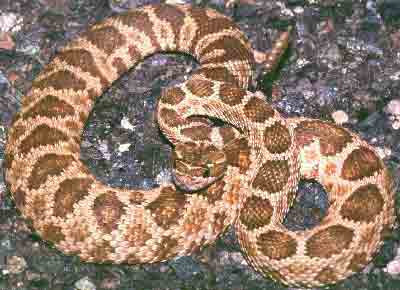
Crotalus viridis
(Western Rattlesnake)
Key Characteristics
Broad, triangular head
Elliptical pupils
Deep pit between nostril and mouth
Keeled scales
Rattle (or "button") on tail
General Description:
Western Rattlesnakes are readily identified with their large triangular head offset by their narrow neck, the deep pit located between their nostrils and their upper labial scales, and of course, their rattle. Neonates lack a well developed rattle, having instead a "button" that will gain new segments each time the snake sheds its skin. The pit in the face is used to detect infrared (heat) signals from potential prey and gives this group of snakes the common name "pit vipers". Western Rattlesnakes have highly keeled scales,and their eyes have vertical pupils. This pupil configuration helps distinguish Western Rattlesnakes from Gopher Snakes who have round pupils. Western Rattlesnakes vary in coloration among subspecies, but generally have a light dorsal coloration (green, tan or gray) that is marked with contrasting dark saddles, which are sometimes edged with white. There is usually a lateral series of blotches as well. The ventral scales are generally a solid cream or yellow color.
There are three subspecies of Western Rattlesnake that occur in Idaho, and they are different enough in coloration to warrant additional description. The subspecies with the smallest range in Idaho is the the Prairie Rattlesnake (Crotalus viridis viridis). Prairie Rattlesnakes are only found in east-central Idaho, in Valley and Lemhi counties (Nussbaum et al. 1983). The ground color of these snakes can be greenish-gray, yellow or brownish gray (Cobb 1996). Prairie Rattlesnakes have wide eyestripes that are bordered on either side by light stripes, and these stripes angle towards the jaw. The blotches on Prairie Rattlesnakes are straight edged, and are bordered by light-colored scales (Nussbaum et al. 1983).
The subspecies found in the southwestern portion of the state is the Great Basin Rattlesnake (Crotalus viridis lutosus). These snakes have less distinct markings on the head, and less prominent body blotches that are irregular in shape and may have light colored centers (Nussbaum et al. 1983). However, I have encountered juvenile Great Basin Rattlesnakes that have light colored outlines around their blotches and on either side of the dark eye stripe. Great Basin Rattlesnakes have a range of ground colors that varies among individuals. The ground color can be buff-gray, yellowish gray or light brown (Cobb 1996).
The subspecies of Western Rattlesnake found in the remaining extent of the species range in Idaho is the Northern Pacific Rattlesnake (Crotalus viridis oreganus). This subspecies is found in west-central, Idaho, in association with the Salmon, Clearwater and Snake River drainages. Northern Pacific Rattlesnakes have head markings similar to C. v. lutosus, but they have dark brown, dark gray or even black ground colors (Nussbaum et al. 1983). Like the Great Basin Rattlesnake, Northern Pacific Rattlesnakes generally lack a light outline around the dorsal markings.
Although not the longest snake species occurring in Idaho, Western Rattlesnakes are the most heavy-bodied. They can reach sizes of up to 163 cm (~65 in.) in total length (Cobb 1996) and males are generally larger than females (Storm and Leonard 1995).
Western Rattlesnakes differ from many Idaho snakes because they can mate at any time during active season, giving birth to 3-12 young, which are born in August or September (Storm and Leonard 1995). The young resemble adults morphologically, except for the prebutton or button that they have before a multi-segmented rattle develops. Juveniles may be more vividly colored than adults.
Habitat:
Western Rattlesnakes are usually found in drier regions with sparse vegetation (Storm and Leonard 1995). The area usually has a rocky component (or at least has one near enough to be utilized as a hibernaculum during the winter). Hibernacula are generally on south facing slopes and are not shaded by vegetation (Nussbaum et al. 1983).
Idaho Distribution:
In Idaho, Western Rattlesnakes are found in all but the northern portion of the state, and at high elevations. From southwestern Saskatchewan, west to southern British Columbia, south to central Baja California and north-central Mexico, and across U.S. from Pacific Coast to western Iowa and central Kansas.
Diet:
Eats mainly small mammals, but may also consume birds, lizards, and amphibians (rarely). In some regions, juveniles prey mostly on lizards rather than on small mammals. In southwestern Idaho, adults prefer mice, wood rats, ground squirrels and rabbits. British Columbia study found that most feeding occurs from June through August.
Ecology:
Primarily terrestrial. Mostly diurnal in cool weather, and nocturnal/crepuscular in hot, summer weather (active in morning and late afternoon in far northern range). Hibernates/aestivates. Remains in mammal burrows, crevices, or caves when inactive; individuals may congregate at hibernation dens, at times with other snake species. Active from about April to November over most of range, and from late March to October in southern British Columbia and northern Idaho. Gravid females may or may not feed, depending on area. Idaho's only dangerously venomous snake species. Preyed upon by raptors such as Red-tailed Hawks.
Reproduction:
Young are born August-October (August-early October in Idaho). Litter size increases with female size. Adult female may not give birth every year; British Columbia study found 2-yr (or more) interval between litters. Northern Idaho study identified females that reproduce in consecutive years; annual versus biannual reproduction was linked to level of fat reserves in body. In areas with short growing seasons, adults require several years to reach sexual maturity (4-6 yr in Idaho; 5-7 yr for females in British Columbia).
Conservation:
|
Status: |
Unprotected nongame species |
|
Global Rank: |
G5 |
|
State Rank: |
S5 |
Important State References:
Diller, L.V. and R.L. Wallace. 1984. Reproductive biology of the northern Pacific rattlesnake (Crotalus viridis oreganus) in northern Idaho. Herpetologica 40:182-193.
Species description, key characteristics and original work by John Cossel Jr. © 1997
Species ecological information from Groves et al. ©1997.
Original images provided by Charlotte Corkran and Jonathon M. Beck © 1997
Design and Optimization by Ean Harker©1999, 2000.
DAI layout by Stephen Burton, and Mike Legler © 1999.
